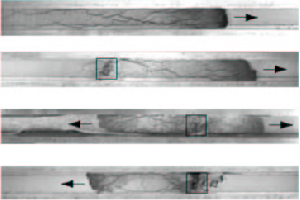Behaviors of amoeba (Physarum plasmodium) in heterogeneous environments

We report here a new kind of behavior that seems to be ’indecisive’ in an amoeboid organism, the Physarum plasmodium of true slime mold. The plasmodium migrating in a narrow lane stops moving for a period of time (several hours but the duration differs for each plasmodium) when it encounters the presence of a chemical repellent, quinine. After stopping period, the organism suddenly begins to move again in one of three different ways as the concentration of repellent increases: going through the repulsive place (penetration), splitting into two fronts of going throught it and turning (splitting) and turning back (rebound). In relation to the physiological mechanism for tip migration in the plasmodium, we found that the frontal tip is capable of moving further although the tip is divided from a main body of organism. This means that a motive force of front locomotion is produced by a local process at the tip. Based on this finding, a mathematical model for front locomotion is considered in order to understand the dynamics for both the long period of stopping and three kinds of behavior. A model based on reaction-diffusion equations succeeds to reproduce the experimental observation. The origin of long-time stopping and three different outputs may be reduced to the hidden instabilities of internal dynamics of the pulse, which may be a skeleton structure extracted from much more complex dynamics imbedded in the Physarum plasmodium.
Reference
[1]Toshiyuki Nakagaki, Makoto Iima,Tetsuo Ueda,Yasumasa Nishiura, Tetsu Saigusa, Atsushi Tero, Ryo Kobayashi, and Kenneth Showalter, "Minimum-Risk Path Finding by an Adaptive Amoebal Network", PRL99, 068104 (2007)
[2]Takagi Seiji, Nishiura Yasumasa, Nakagaki Toshiyuki, Ueda Tetsuo and Ueda Kei-ichi, "Indecisive behavior of amoeba crossing an environmental barrier", Proceedings of Int. Symp. on Topological Aspects of Critical Systems and Networks, World Scientific Publishing Co. 86-93 (2007)
[3] T. Nakagaki, R. Kobayashi, T. Ueda and Y. Nishiura: "Obtainning multiple separate food sources: Behavioural intelligence in the Physarum plasmodium", Proc. R. Soc. Lond. B, 271: 2305-2310 (2004)

